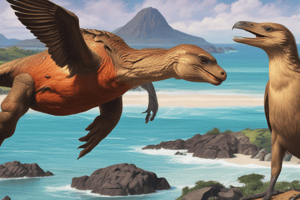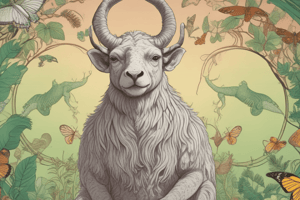Podcast
Questions and Answers
What is the term for changes in gene/allele frequency over generations?
What is the term for changes in gene/allele frequency over generations?
- Natural selection
- Microevolution (correct)
- Genetic drift
- Mutation
What causes new species to emerge?
What causes new species to emerge?
- Speciation (correct)
- Microevolution
- Genetic drift
- Mutation
Which process explains the build-up of genetic changes in a population over time?
Which process explains the build-up of genetic changes in a population over time?
- Genetic drift (correct)
- Mutation
- Natural selection
- Gene flow
What can cause gene pools to become increasingly different from the original pool?
What can cause gene pools to become increasingly different from the original pool?
Which barrier leads to the fragmentation of gene pools during speciation?
Which barrier leads to the fragmentation of gene pools during speciation?
What process occurs when genetic changes result in a population hunting in water versus on land, like Garter snakes?
What process occurs when genetic changes result in a population hunting in water versus on land, like Garter snakes?
What is the primary source of gene pools for future speciation?
What is the primary source of gene pools for future speciation?
Which statement best describes homologous structures?
Which statement best describes homologous structures?
Why can species have very different phenotypes despite being closely related?
Why can species have very different phenotypes despite being closely related?
Which pairs of traits are examples of convergent evolution?
Which pairs of traits are examples of convergent evolution?
What is the relationship between apes and humans according to the text?
What is the relationship between apes and humans according to the text?
Which of the following is NOT a theory according to the text?
Which of the following is NOT a theory according to the text?
What is the definition of microevolution?
What is the definition of microevolution?
What is the primary cause of genetic diversity in a population?
What is the primary cause of genetic diversity in a population?
What does the term 'gene pool' refer to?
What does the term 'gene pool' refer to?
How is the genetic composition of a population measured?
How is the genetic composition of a population measured?
What is the outcome of gene flow?
What is the outcome of gene flow?
What is the first mechanism of microevolution?
What is the first mechanism of microevolution?
What is the primary cause of allele frequency change in genetic drift?
What is the primary cause of allele frequency change in genetic drift?
Which of these circumstances makes genetic drift likely?
Which of these circumstances makes genetic drift likely?
What is a population 'bottleneck'?
What is a population 'bottleneck'?
What is the definition of 'relative fitness'?
What is the definition of 'relative fitness'?
What is the primary cause of allele frequency change in natural selection?
What is the primary cause of allele frequency change in natural selection?
Which of these is an example of natural selection?
Which of these is an example of natural selection?
Which phylum do starfish belong to?
Which phylum do starfish belong to?
What type of endoskeleton do chondrichthyes have?
What type of endoskeleton do chondrichthyes have?
Which class of chordates includes animals that are the first to colonize land?
Which class of chordates includes animals that are the first to colonize land?
What is a unique feature of some reptiles that is not a defining mammalian trait?
What is a unique feature of some reptiles that is not a defining mammalian trait?
What percentage of all mammals belong to the two most species-rich mammalian orders?
What percentage of all mammals belong to the two most species-rich mammalian orders?
What major event occurs in the life cycle of amphibians?
What major event occurs in the life cycle of amphibians?
Flashcards are hidden until you start studying
Study Notes
Microevolution
- Microevolution: changes in gene/allele frequency over generations, causing a change in the phenotype of a population over time
- Mechanisms of microevolution:
- Genetic drift: allele frequency change due to chance, regardless of the allele's usefulness
- Natural selection: allele frequency change due to the allele's associated phenotype being an advantage or disadvantage in a particular environment
- Gene flow: migration adds or removes alleles from a gene pool
- Mutations: brand new alleles that can occur before any of the other three mechanisms
Genetic Drift
- Genetic drift: allele frequency change due to chance, regardless of the allele's usefulness
- Circumstances that make drift likely:
- The associated phenotype is not an advantage or disadvantage
- Small populations: more likely to change due to a chance event, regardless of the allele's usefulness
- Population bottleneck: population crashes over a short time, alleles lost regardless of allele value
- If the population begins to increase again, the lost alleles may not be recovered
Natural Selection
- Natural selection: allele frequency change due to the allele's associated phenotype being an advantage or disadvantage in a particular environment
- Allele's associated phenotype is defined as an advantage or disadvantage if it is associated with reproductive success
- Relative fitness: the number of surviving offspring over a lifetime, relative to others in the population
Speciation
- Speciation: the process of population divergence, resulting in new species
- Two key steps:
- Gene pool fragmentation: a reproductive barrier occurs, causing geographic isolation, habitat isolation, behavioral isolation, or temporal isolation
- New gene pools become increasingly different: microevolution, mutations, natural selection, and genetic drift occur, leading to the formation of new species
Patterns of Evolution
- Diversification: new species and whole new lineages occur due to speciation
- Transitional species: have ancestral and new traits, may have intermediate phenotypes
- Homologous structures: related species have shared structures, same source, subsequently modified by natural selection
- Divergent evolution: species can have very different phenotypes even if they are fairly closely related
- Convergent evolution: species can have very similar phenotypes even if they are not closely related
Macroevolution
- Macroevolution: the development of new species and families of species
- Six patterns of evolution:
- Diversification
- Transitional species
- Homologous structures
- Divergent evolution
- Convergent evolution
- Speciation
- Evolution is not a guess, but a scientific theory, like germ theory, cell theory, and genetic theory
Kingdom Characteristics
- Kingdom Plantae: characteristics
- Kingdom Fungi: characteristics
- Kingdom Animalia: characteristics
- Levels of biological organization
Studying That Suits You
Use AI to generate personalized quizzes and flashcards to suit your learning preferences.




